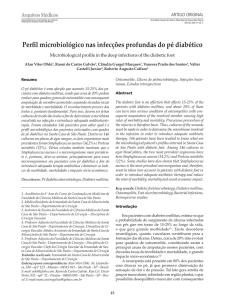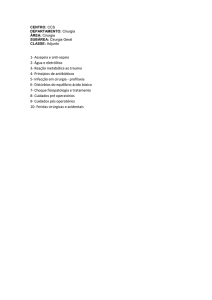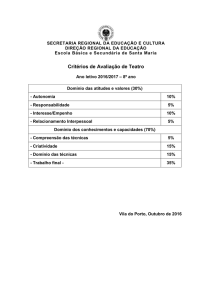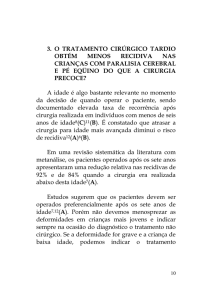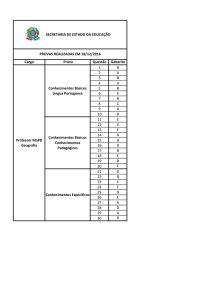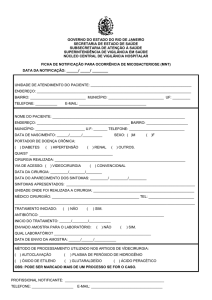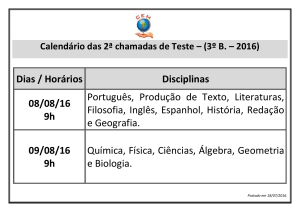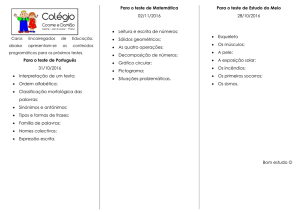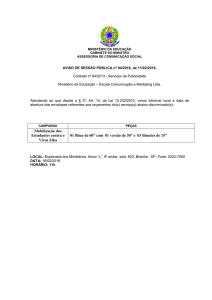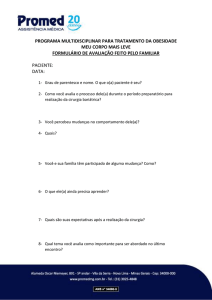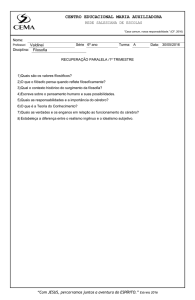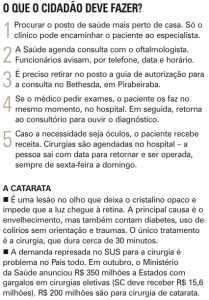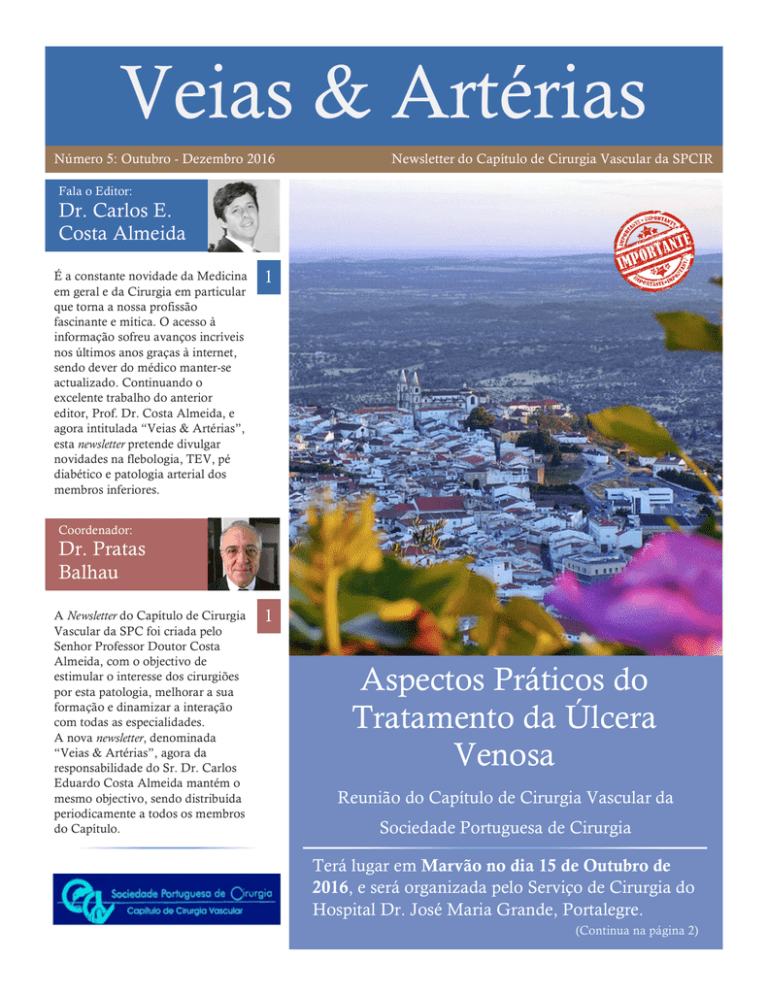
Veias & Artérias
Número 5: Outubro - Dezembro 2016
Newsletter do Capítulo de Cirurgia Vascular da SPCIR
Fala o Editor:
Dr. Carlos E.
Costa Almeida
É a constante novidade da Medicina
em geral e da Cirurgia em particular
que torna a nossa profissão
fascinante e mítica. O acesso à
informação sofreu avanços incríveis
nos últimos anos graças à internet,
sendo dever do médico manter-se
actualizado. Continuando o
excelente trabalho do anterior
editor, Prof. Dr. Costa Almeida, e
agora intitulada “Veias & Artérias”,
esta newsletter pretende divulgar
novidades na flebologia, TEV, pé
diabético e patologia arterial dos
membros inferiores.
1
Coordenador:
Dr. Pratas
Balhau
A Newsletter do Capítulo de Cirurgia
Vascular da SPC foi criada pelo
Senhor Professor Doutor Costa
Almeida, com o objectivo de
estimular o interesse dos cirurgiões
por esta patologia, melhorar a sua
formação e dinamizar a interação
com todas as especialidades.
A nova newsletter, denominada
“Veias & Artérias”, agora da
responsabilidade do Sr. Dr. Carlos
Eduardo Costa Almeida mantém o
mesmo objectivo, sendo distribuída
periodicamente a todos os membros
do Capítulo.
1
Aspectos Práticos do
Tratamento da Úlcera
Venosa
Reunião do Capítulo de Cirurgia Vascular da
Sociedade Portuguesa de Cirurgia
Terá lugar em Marvão no dia 15 de Outubro de
2016, e será organizada pelo Serviço de Cirurgia do
Hospital Dr. José Maria Grande, Portalegre.
(Continua na página 2)
Número 5: Outubro – Dezembro 2016
Foto: CE Costa Almeida
Veias & Artérias – Newsletter
(Continuação)
Trat. Úlcera Venosa
Programa da reunião:
8:30 – Abertura do secretariado
9:00 – Cerimónia de abertura
Presidente: Pratas Balhau
Moderadores:
Mónica Guerrero, Penalva Santos, Miguel Romero,
Daniela Rosado
Comentadores:
Eduardo Soeiro, Hugo Capote, Conceição Marques,
Luís Silveira
9:30 – Diagnostico diferencial da úlcera venosa
Carlos Eduardo Costa Almeida
9:40 – Fisiopatologia da úlcera venosa
Cristina Costa, Nuno Pratas
Cirurgia em
Imagens
1. Eczema varicoso
evidente sobre variz
troncular.
Artigos e Opiniões
Sugestão de leitura:
Van Gent W, Wittens C. Influence of
perforating veins surgery in patients
with venous ulceration. Phlebology
2015; 30 (2): 127-132.
Link: http://www.ncbi.nlm.nih.gov/pubmed/24357450
9:50 – Discussão
10:30 – Coffee Break
Presidente: Costa Almeida
Moderadores: J. Neves, Manuel Neuparth, João
Magro, Guilherme Fialho
Comentadores: Daniel Cartuxo, Luís Filipe, Luís
Carvalho, Luís Reis, Amélia Coelho
11:00 – Tratamento local: visão do medico e
visão do enfermeiro
Natália Santos, Paula Pinheiro
11:20 – Tratamento medico
Gilberto Figueiredo
11:30 – Tratamento cirúrgico
Aida Paulino, Pedro Vaz
12:00 – Discussão
Pereira Alves C, Neves J, Pinheiro V,
Moniz L, Toscano F, Figueiredo J, et
al. Varicose veins surgery of lower
limbs. Can we preserve the great
saphenous vein? Revista Portuguesa
de Cirurgia 2016; 37: 17-23.
Link:
http://revista.spcir.com/index.php/spcir/article/view/468
12:30 – Doença venosa: É possível a prevenção?
Pereira Alves
13:00 – Encerramento
Local: Quinta da Nave do Lobo, São Salvador
de Aramenha, Marvão.
Inscrição grátis mas obrigatória até 10 de Outubro.
SPC: tel. 218479225, e-mail: [email protected]
2
Número 5: Outubro – Dezembro 2016
Veias & Artérias – Newsletter
CASE REPORT – OPEN ACCESS
Cursos, Reuniões e
Congressos:
International Journal of Surgery Case Reports 21 (2016) 48–51
Contents lists available at ScienceDirect
International Journal of Surgery Case Reports
journal homepage: www.casereports.com
Collagen implant with gentamicin sulphate as an option to treat a
neuroischaemic diabetic foot ulcer: Case report
C.E. Costa Almeida ∗
Centro Hospitalar e Universitário de Coimbra (Covões), Surgery C, Centro Hospitalar de Coimbra (Covões), Quinta dos Vales, São Martinho do Bispo,
Coimbra, Portugal
a r t i c l e
i n f o
Article history:
Received 3 October 2015
Received in revised form 17 February 2016
Accepted 18 February 2016
Available online 26 February 2016
Keywords:
Diabetic foot
Collagen implant
Neuroischaemic foot
Diabetes
Publicações:
a b s t r a c t
INTRODUCTION: The ischaemic diabetic foot is associated with a faster evolving atherosclerosis affecting
preferentially the bellow knee arteries. This distal ischemia associated with a wide distribution of multiple stenosis and occlusions throughout lower limb arteries, makes revascularization very hard or even
impossible. This represents a major factor responsible for non-healing diabetic foot ulcer. In these cases
all efforts should be made to find treatment alternatives that can promote ulcer healing.
CASE PRESENTATION: Male patient with neuroischaemic diabetic foot ulcer with exposure tendon, without
possibility for endovascular or surgical revascularization, was treated unsuccessfully with prostaglandin
and several types of dressings for 7 months. Skin graft failed. Weekly dressings with collagen implant
impregnated with gentamicin sulphate were then started and continued in an outpatient setting. Evolution was very positive, with 99% of epithelisation in 9 months. No pain or infection since the beginning
of this treatment.
DISCUSSION: Successful treatment of a neuroischaemic diabetic foot ulcer rests with the possibility of
increasing the perfusion to the foot. Whether or not a revascularization procedure is possible will set the
tone for the ensuing treatment. Using collagen implant with gentamicin sulphate, collagen is delivered
to the wound bed helping in the granulation tissue formation, will increase microcirculation, and topic
gentamicin will decrease bacterial load, exudate and proteases production, increasing cicatrisation.
CONCLUSION: In neuroischaemic diabetic foot ulcer weekly dressings with collagen implant impregnated
with gentamicin sulphate can be a good option for ulcer healing.
© 2016 The Authors. Published by Elsevier Ltd. on behalf of IJS Publishing Group Ltd. This is an open
access article under the CC BY-NC-ND license (http://creativecommons.org/licenses/by-nc-nd/4.0/).
International Journal of Surgery
Case Reports
1. Introduction
Diabetic foot can have an extreme negative impact in the quality
of life (Q-o-L) of patients, and is a burden to all health care systems.
It will affect about 15% of all diabetic patients, and from those 18%
will have a limb amputation [1]. The risk of foot ulceration in a
diabetic’s patient lifetime may be as high as 25% and is the most
common cause of amputation [2]. In five years time 66% of them
will have a contralateral amputation [1]. Diabetic foot can be neuropathic, ischaemic or septic, but most of the times combines two or
more of this characteristics. The ischaemic diabetic foot has some
particularities that make this patient different than the ischaemic
non-diabetic one. Claudication is most of the times absent due to
concomitant neuropathy (mix blessing), which gives the patient
a false sense of health. Additionally atherosclerosis in a diabetic
patient evolves faster, and has a wider distribution throughout
lower limb arteries, affecting preferentially the bellow knee arter-
ies (distal ischemia) [3]. Because of this distal ischemia and wide
distribution of multiple stenosis and occlusions throughout lower
limb arteries, revascularization of an ischaemic diabetic foot can
be very difficult or even impossible. This represents a major factor
responsible for non-healing diabetic foot ulcer and for limb amputation [2]. In these cases all efforts should be made to find treatment
alternatives that can promote ulcer healing and save limbs.
The author presents and analyze a case of a patient with an
ischaemic diabetic foot ulcer without possibility for revascularization treated with collagen implant impregnated with gentamicin
sulphate (Collatamp® ). This case report is compliant with the CARE
guidelines.
O pé diabético é um flagelo que atinge inúmeros doentes da sociedade
portuguesa. O Serviço de Cirurgia C do Centro Hospitalar e
Universitário de Coimbra tem tido um papel importante junto da
comunidade local no que diz respeito ao tratamento do pé diabético. A
consulta de Pé Diabético Cirúrgico realizada pelos Dr. CE Costa
Almeida e Dr. Armando Infuli é disso
umpresentation
exemplo, estando
2. Case
direccionada para os casos específicos Ade
pé
81yo malediabético
patient with nonisquémico.
insulin-treated type 2 diabetes
resorted to the emergency department in June 2014 because of a
third degree burn wound with 12 × 10 cm on the right instep with
Neste âmbito mais um trabalho foi recentemente
publicado no
exposure tendon. Additionally he had fever and inflammatory signs
the wound. Although no distal pulses were noted on physi“International Journal of Surgery – around
Case
Reports”.
Sob a autoria do
cal examination, the patient did not referred claudication and blood
Dr. CE Costa Almeida, o trabalho “Collagen implant with
gentamicin sulphate as an option to treat a neuroischaemic diabetic
foot ulcer: Case report” foi publicado com acesso livre online.
1º Congresso Nacional de
Pé Diabético
Sociedade Portuguesa de Diabetologia,
Associação Protectora dos Diabéticos de
Portugal
Apoios: DGS, Programa nacional para a
diabetes
Hotel Aldeia dos Capuchos, Costa da
Caparica, 14-15 Outubro 2016
Aspectos Práticos do
Tratamento da Úlcera
Venosa
Serviço de Cirurgia do HDJMG da
Unidade Local de Saúde no Norte
Alentejano, Portalegre
Apoios: Capitulo de Cirurgia Vascular
da Sociedade Portuguesa de Cirurgia
Quinta da Nave do Lobo, São Salvador
da Aramenha, Marvão, 15 de Outubro
de 2016
∗ Corresponding author.
E-mail address: [email protected]
http://dx.doi.org/10.1016/j.ijscr.2016.02.023
2210-2612/© 2016 The Authors. Published by Elsevier Ltd. on behalf of IJS Publishing Group Ltd. This is an open access article under the CC BY-NC-ND license (http://
creativecommons.org/licenses/by-nc-nd/4.0/).
Neste caso um doente com pé diabético neuroisquémico sem
possibilidade de revascularização, com úlcera no dorso do pé após
queimadura e com exposição tendinosa, em que outros pensos e um
enxerto de pele falharam, teve uma evolução muito boa com pensos
semanais de Cronocol®.
XXVIII Encontro
Internacional de Cirurgia
Serviço de Cirurgia do Centro
Hospitalar de Vila Nova de Gaia /
Espinho
Porto, 14-15 de Novembro de 2016
Link: http://www.ncbi.nlm.nih.gov/pubmed/26927956
“A blog about
surgery”
Dia da SEPS
Serviço de Cirurgia C, CHUC-CHC
Apoios: Sociedade Portuguesa de
Cirurgia, Medtronic, Servier
Coimbra, 2017 (data a designar)
Link: http://carloscostaalmeida.wixsite.com/surgicalthoughts
3
Número 5: Outubro – Dezembro 2016
Veias & Artérias – Newsletter
Tem a palavra ...
Esta secção foi criada especialmente para si, o leitor.
Está reservada para transmitir aos restantes leitores a
sua opinião sobre os mais diversos temas, sejam eles:
Tem a Palavra
•
noticias cirúrgicas
•
artigos recentes ou menos recentes que ache de
interesse relevante comentar
•
opinião sobre reuniões passadas
•
sugestões sobre próximas reuniões
•
críticas / revisões de notícias publicadas na
“Veias & Artérias”
Data limite de envio de opiniões a publicar: último dia do segundo mês do
trimestre a que corresponde a última newsletter publicada
As secções “Cirurgia em Imagens” e “Publicações” da Veias & Artérias estão abertas a sugestões de publicação.
Na “Cirurgia em Imagens” são publicadas imagens interessantes e sugestivas relacionadas com patologia vascular. Qualquer leitor
pode (e deve) participar enviando fotografia da sua autoria e respectiva legenda (máximo 4-5 palavras) que ache interessante e mereça
ser partilhada. Quanto à secção “Publicações” são publicitados artigos recentemente publicados, com interesse para a comunidade
cirúrgica, dando preferência a publicações de autores nacionais e pertencentes ao Capítulo de Cirurgia Vascular da SPC.
Data limite para envio: último dia do segundo mês do trimestre a que corresponde a última newsletter publicada
Nome do leitor
Email do leitor
Assunto: publicação na secção ...
Ficheiros anexos
Carlos Eduardo Costa Almeida
[email protected]

